Having considered Chambertin’s top five wines for Quality last week, this week our Listed section travels south-west to look at Margaux’s overall best red wines. Whilst it is to be expected that Margaux’s eponymous first growth tops the table, with an outstanding score of 970, the order of the remaining four wines – and the appearance of second wine Pavillon Rouge – might come as more of a surprise.
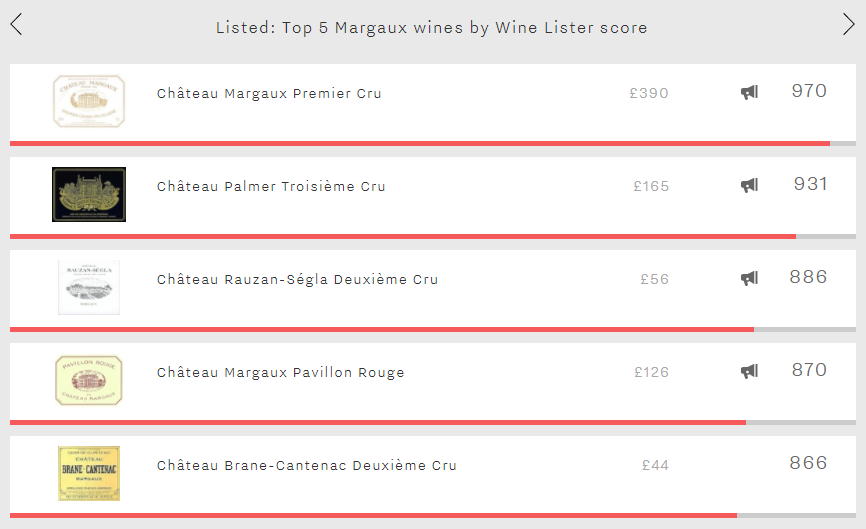
Château Margaux’s dominance is the result of a lead across nine of Wine Lister’s 12 rating criteria, resulting in an advantage in both the Quality and Brand categories. In particular, it outperforms the others in the Quality category with an excellent score of (962), nearly 80 points ahead of the second-best wine in the category – Palmer (885), which leapfrogs the group’s two second growths in terms of quality. However, Château Margaux is pipped to the post in the Economics category by Pavillon Rouge, whose superior price performance helps it to overcome its older sibling.
Palmer achieves Margaux’s second-best overall score (931). The third growth’s brand is its strongest asset. Despite trailing Château Margaux by two points in the category, its score of 995 is the 15th best Brand score in the entirety of Wine Lister’s database. It even sneaks ahead of Château Margaux in terms of restaurant presence (47% vs 46%), although it can’t quite match its illustrious neighbour in terms of vertical presence, with 4.1 vintages / formats offered per list on average, compared to Château Margaux’s 5.7. It is also searched for nearly three times less frequently than Château Margaux.
Pavillon Rouge occupies fourth position. It enjoys the group’s best Economics score, in-keeping with the unstoppable performance of first growths’ second wines in general. This is the result of strong price growth rates – it has a three-year compound annual growth rate (CAGR) of 15.5% and has added over 11.3% to its price in the last sixth months alone. The chart below confirms that its economic strength is not only at odds with its lack of classification, but also with its Quality score, which is the lowest of the group.
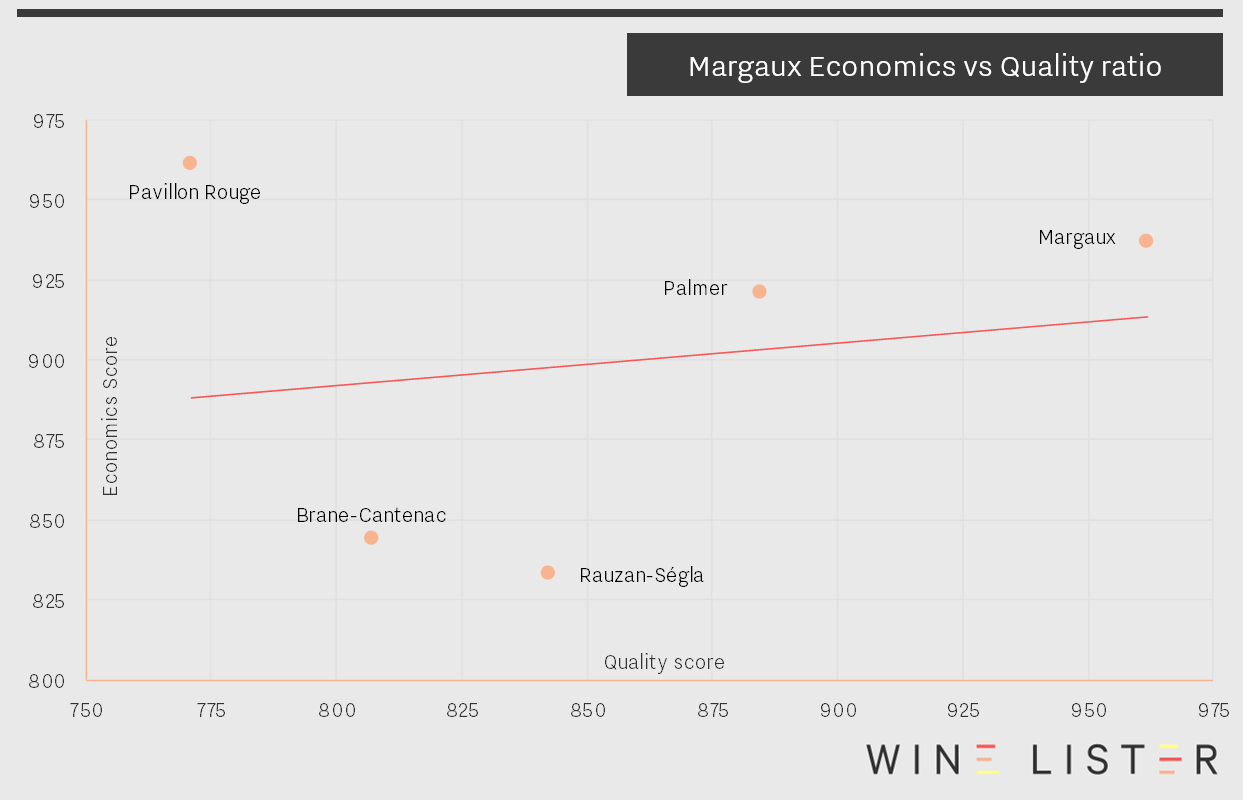
Pavillon Rouge is sandwiched between two second growths – Rauzan Ségla (886) and Brane-Cantenac (866). Despite belonging to the same class, they perform quite differently. Rauzan-Ségla experiences the group’s weakest economic profile (836), but climbs back up the table in the Quality and Brand categories (842 and 970 respectively), ahead of fifth-placed Brane-Cantenac.
Any of these wines would be a very worthy addition to your Christmas table. Happy Christmas from the whole team at Wine Lister!
If ever there was a time of year to push the boat out, then surely this is it. So this week our Listed section travels to Burgundy for Chambertin’s top five wines for Quality. All achieving a Quality score of at least 966, thus ranking amongst the very best on Wine Lister’s database, these are some of the most sought-after wines in the world.
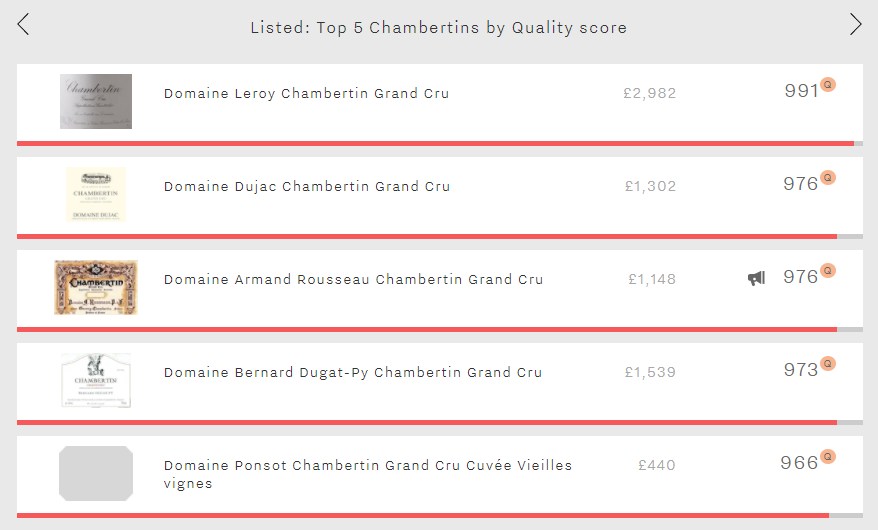
Leading the way with a score of 991 is Leroy’s offering. This exceptional score is the third-best Quality score on Wine Lister and the highest of any red wine (alongside DRC La Romanée-Conti). Across all vintages, it receives near-perfect ratings from Wine Lister partner critics Jancis Robinson and Jeannie Cho Lee (19.5/20 and 99/100 respectively). Moreover, Jeannie Cho Lee awarded a 100 point score to the 2015 vintage. But with the longest ageing potential of the group – over 18 years on average – the 2015 will reward patient drinkers, and with a wine-level average price of £2982 per bottle, you would want to savour it at its peak.
Next come Dujac and Rousseau’s offerings with scores of 976. Whilst these wines achieve identical Quality scores, and similar Economics ratings (951 and 979 respectively), the Rousseau achieves a far superior Brand score (960 vs 608). In fact Rousseau’s Chambertin convincingly outperforms the others in the Brand category, which achieve an average score of 638. The chart below confirms that Rousseau’s Chambertin enjoys far greater brand recognition than its Quality score would suggest within this set of peers, definitely earning its Buzz Brand status.
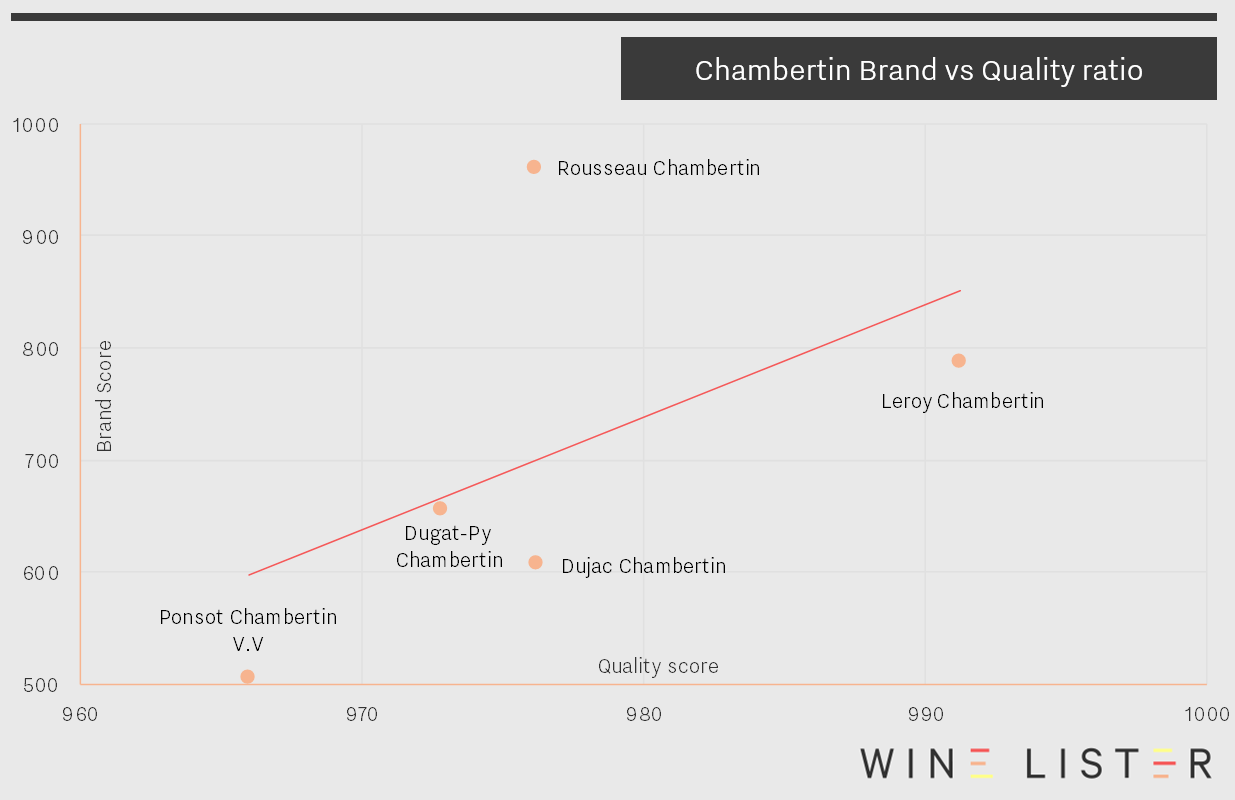
In fourth place is Dugat-Py’s Chambertin (973), just seven points ahead of Ponsot’s Chambertin Cuvée Vieilles Vignes (966). Despite their similar Quality scores, there is a noticeable difference in their prices, with the Dugat-Py the second most expensive wine in the group (£1539), whilst the Ponsot is by far the cheapest (£440) and looks relatively good value. If we look a little further, Ponsot Chambertin 2007, with a Quality score of 968 is currently available for as little as £399 per bottle and is in the middle of its drinking window, making it an excellent proposition for that seasonal treat.
If you are interested in Burgundy and its position in the fine wine market, then watch this space for our forthcoming in-depth regional study, due to be released in January.
This week’s top five takes Wine Lister to the Douro Valley in search of its vintage ports. In some ways this top five is very much a four plus one, with the fifth placed Quinta do Noval Nacional, costing nine to ten times more than each of the others. It is also the only one to enjoy Buzz Brand status. At a total Wine Lister score of 880 and £521 per bottle, against the top-ranked Taylor’s 932 and £60, that constitutes quite a buzz.
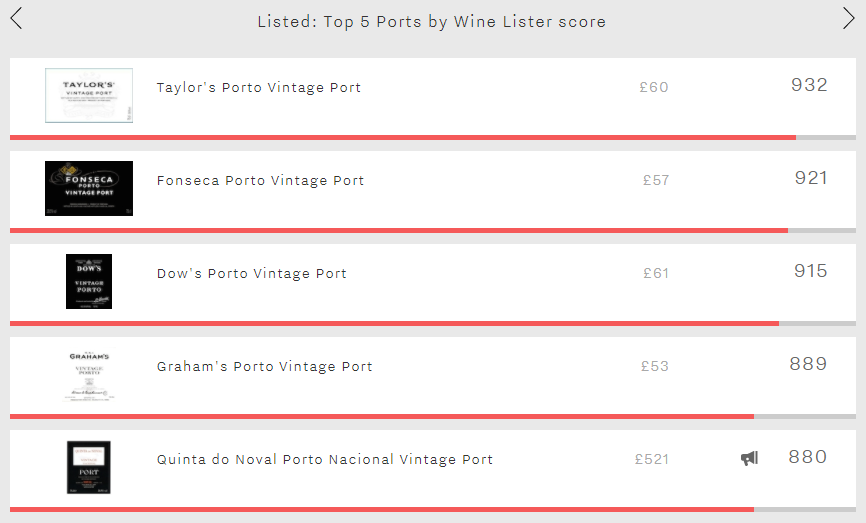
Here is a classic case of all metrics count but some count for more than others when it comes to cost. With a stonking 981 for Quality and the longest drinking window in its peer group the Quinto do Noval is clearly the nichest of the niche; its relatively low restaurant presence (9%) and monthly searches (2,457, on average, to Taylor’s 10,787) make its Wine Lister Brand score (825) well below Taylor’s and the other three.
With an overall score of 932, an excellent Quality score of 967, and a Brand score of 965 based on decent restaurant presence (23%) and over 10,700 average monthly searches, Taylor’s tops the Vintage ports. Fonseca comes a close second at an overall 921. With almost identical Quality (965) and slightly lower Brand (942), Fonseca just pips Taylor’s for liquidity, with 1,072 (against 1,061) of its top five vintages traded at auction in the past year.
At around £60 per bottle on average, Taylor’s and Fonseca are each affordable flutters with future Christmases in mind. Even illustrious older vintages such as 1970 and 1977 – in their drinking prime this Christmas – can be found at two to three times the price.
The same goes for third-placed Dow’s (£61) and fourth-placed Graham’s (£53). At an overall 915 Dow’s has a slightly lower Quality score than the top two. 943 is nevertheless still highly creditable. Graham’s edges Dow’s on Quality at 948 but a relatively lowly 650 for Economics brings it down to 889 overall.
All in all, Taylor’s and Fonseca merit their top two spots. If Santa has very deep pockets then consider adding Quinto do Noval 1994 to your wishlist (at a cool £1,229).
As the temperature drops, the natural reaction can be to reach for structured reds and hearty meals. The great Chardonnays of Corton-Charlemagne also warm the cockles, and belong in pride of place on any Christmas table. Here we look at the appellation’s top five brands.
Wine Lister’s Brand score measures a wine’s prestige – as indicated by its visibility in the world’s top restaurants – and popularity – as shown by the number of searches it receives each month on Wine-Searcher. Corton-Charlemagne’s top brand is Bonneau du Martray’s offering (947). This outstanding Brand score is the result of achieving by far the greatest level of restaurant presence of the group – it is visible in nearly twice as many of the world’s top establishments as the next-best of the five (Coche-Dury’s Corton-Charlemagne) – coupled with being comfortably the most popular of the group, receiving 24% more searches each month than the runner-up. No wonder it is one of the group’s three Buzz Brands.
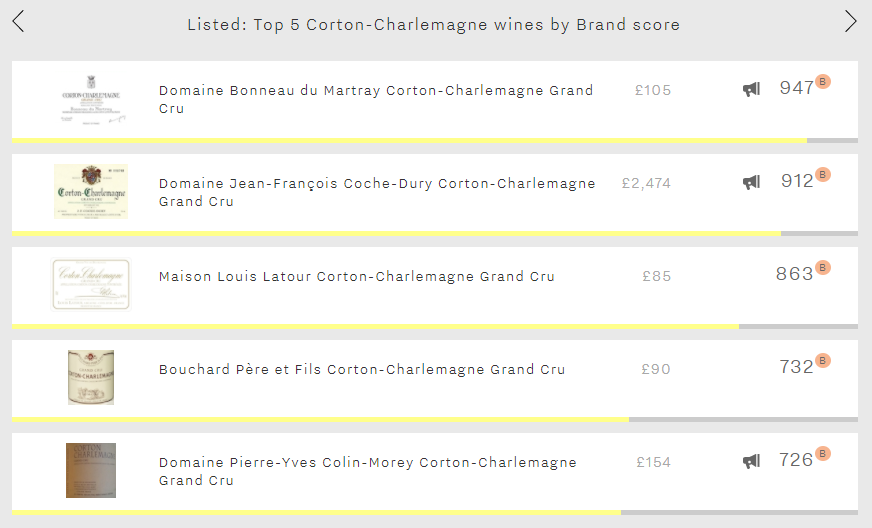
In second place is Coche-Dury’s offering with a score of 912 for Brand, in fact its weakest category – perhaps unsurprising given its formidable Economics and Quality scores (985 – the highest of any white Burgundy – and 969 respectively). Its economic might is the result of its extraordinary price (£2,474), which is over 15 times higher than the second-most expensive wine of the group (the Pierre-Yves Colin-Morey (£154).
Almost 50 points further behind is Maison Louis Latour’s Corton Charlemagne (863). Unlike the Coche-Dury, its Brand score is its best facet. This is thanks to very strong performance across both brand criteria – it features in 13% of top restaurants and receives 2,500 searches each month on average.
Trailing over 130 points further behind, Corton-Charlemagne’s next-strongest brands are separated by just six points – Bouchard Père et Fils (732) and Pierre-Yves Colin-Morey (726). Whilst strong, their Brand scores are no match for their excellent quality scores (917 and 950 respectively). In fact, it seems that quality doesn’t play an obvious role in establishing brand strength within Corton-Charlemagne:
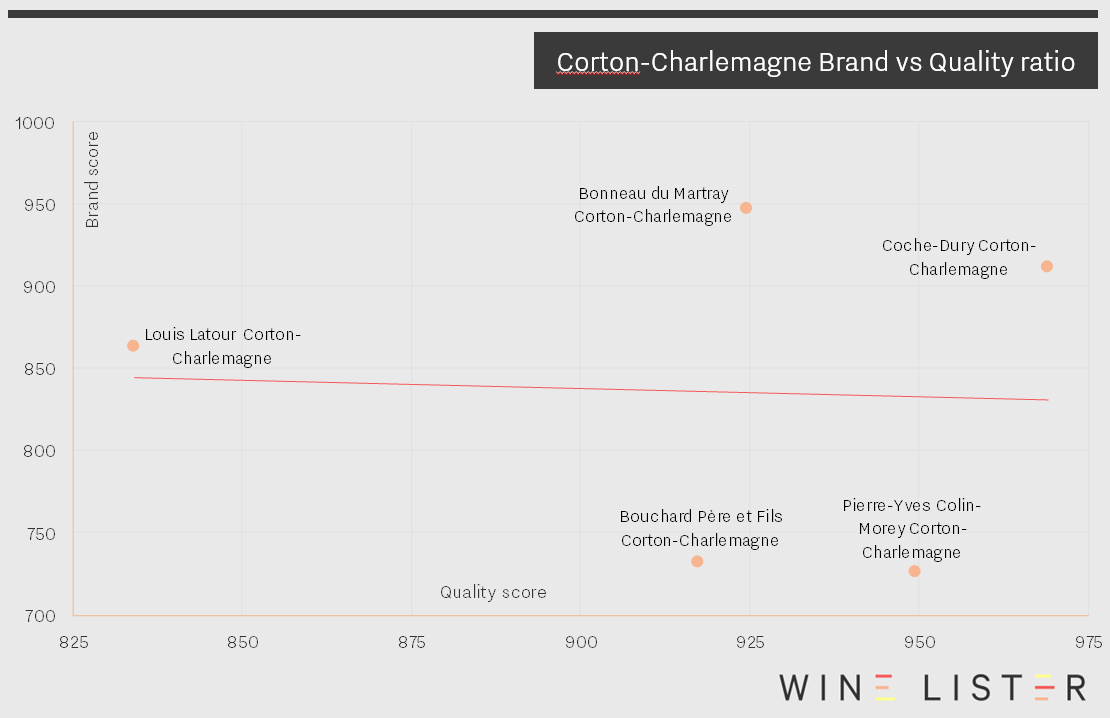
Whilst Corton-Charlemagnes’s top five Brands display no correlation between quality and brand recognition, as indicated by the flat trendline, quality is much more of a factor for the top brands of another of Burgundy’s most prestigious appellations, Montrachet:
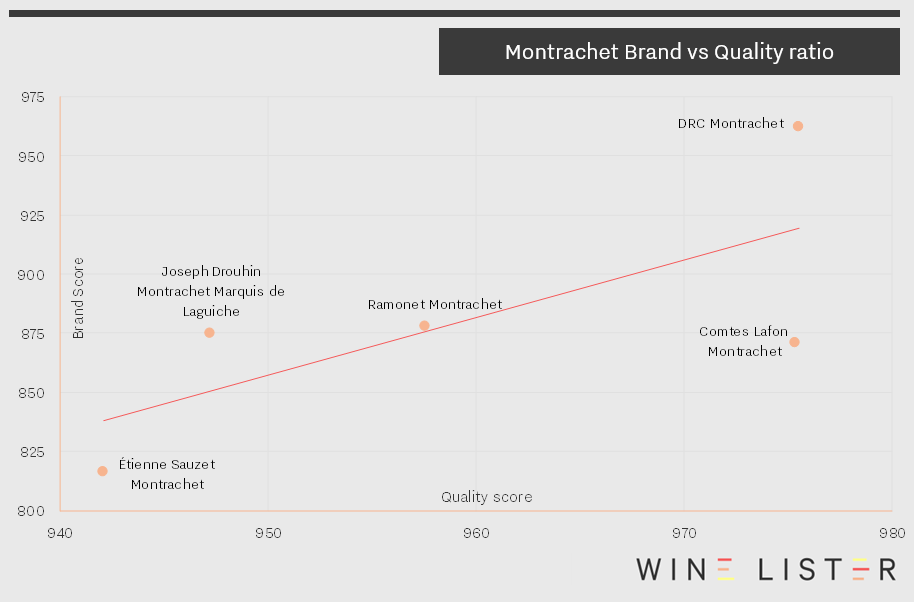
Remember that even if you don’t currently have a Wine Lister subscription you can access all the underlying data behind these five wines as well as those featured in other recent Top 5s, giving you an insight into the wealth of tools at our subscribers’ disposal.
As we edge ever closer to Christmas, it feels appropriate to take a look at sweet wines. Here we consider Alsace’s top 5 sweet whites by overall Wine Lister score. Produced in a thin sliver of land in the far East of France, Alsace’s top sweet whites are separated by just nine points (less than one hundredth of Wine Lister’s 1,000-point scale!). The five wines display very similar profiles, all outperforming in the Quality category, achieiving middling Brand scores, and trailing economically.
Four break the 900-point boundary in terms of Quality scores, putting them amongst the very top quality wines on Wine Lister. Hugel et Fils Riesling Vendange Tardive (VT) falls just short with 881 points, still a very strong Quality score (thanks to 17/20 from both Jancis Robinson and Bettane+Desseauve, and 92.5/100 from Vinous). The same producer’s Gewürtzraminer VT scores even higher for quality (910) thanks to a 95/100 from Jeannie Cho Lee:
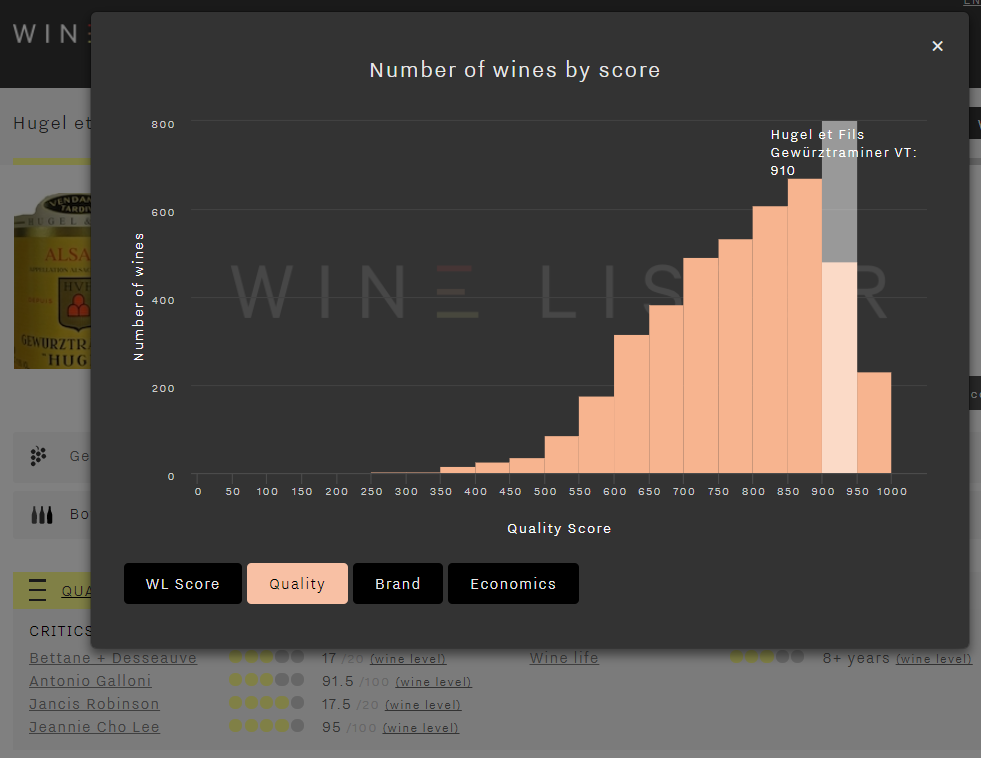
Moving categories, scores drop sharply from an average Quality score of 915 to 550 for Brand – still above the average for all wines on Wine Lister:
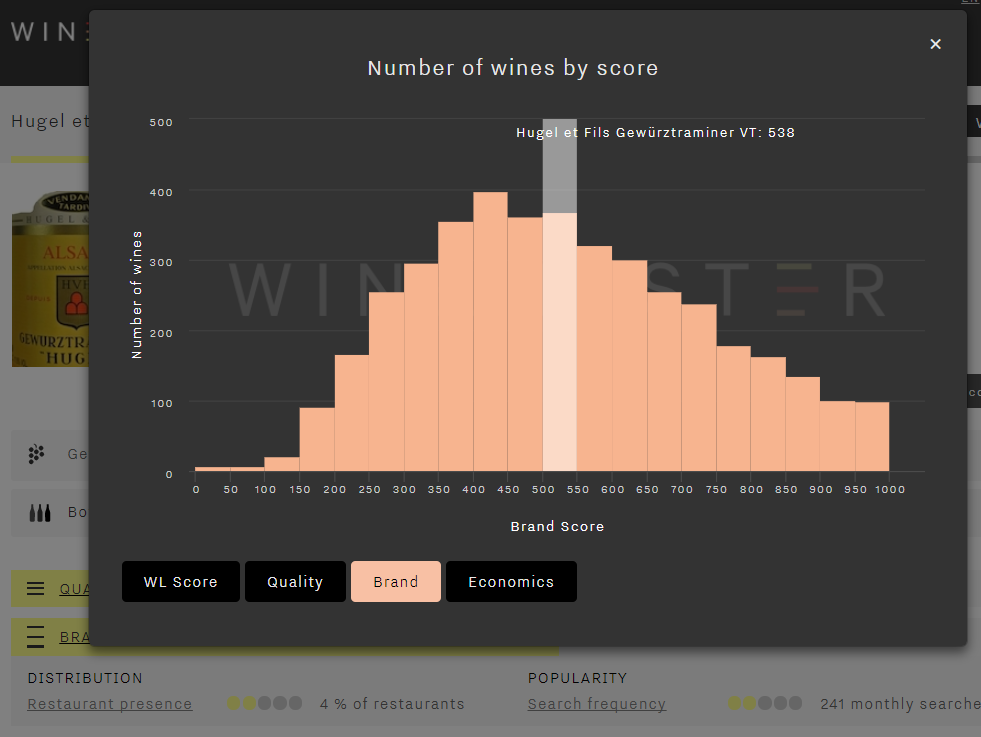
Economics scores trail even further behind, averaging 338, hindered by low liquidity. For example, Hugel’s Gewürtzraminer VT failed to trade a single bottle at auction over the past four quarters (as measured by Wine Market Journal). The chart below shows Economics score in the context of all the wines on Wine Lister – its is well below the average, with a score below 400 putting in the “weak” score band:
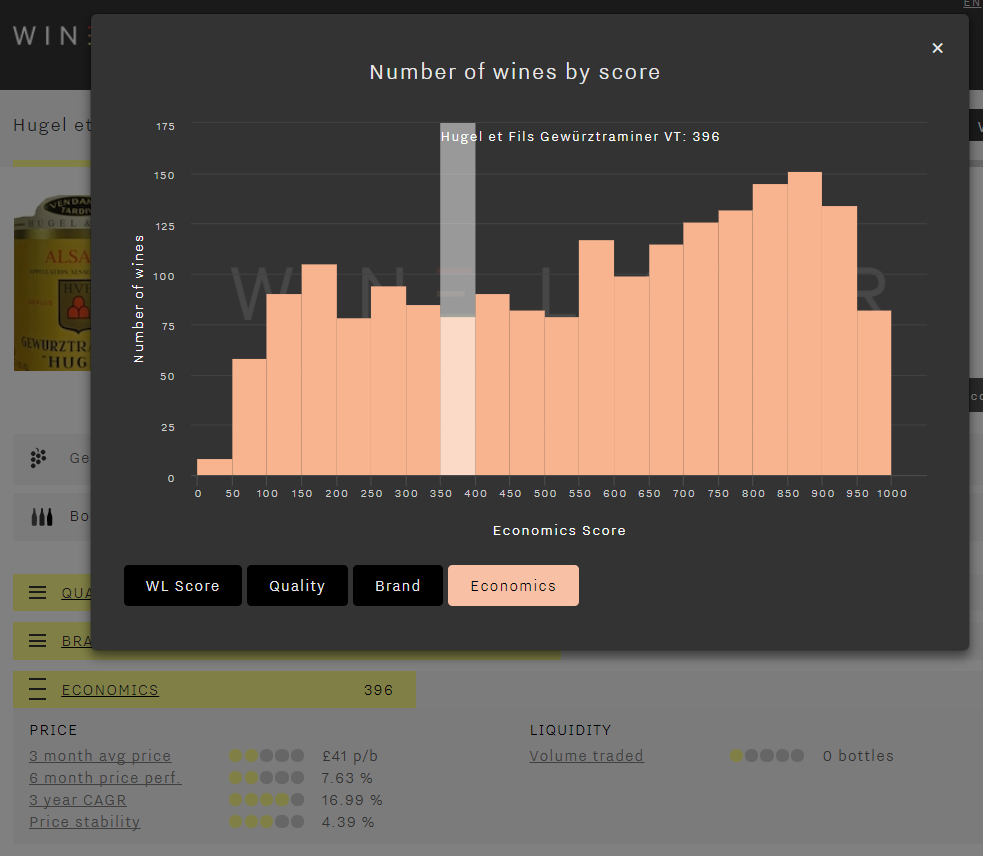
Other wines making the top five are Zind-Humbrecht Jebsal Pinot Gris VT (675) and Trimbach Gewürztraminer VT, which achieves the best restaurant presence of the group. However, featuring on just 6% of the world’s best restaurant lists, this suggests that Alsace’s sweet whites are not every sommelier’s must-list bracket, even when produced by the region’s most famous producer. Incidentally, Trimbach’s Clos Sainte Hune appears in 34% of wine lists (compared to 69% for Sauternes’ Château d’Yquem).
The last wine making it into this week’s Listed section is Marcel Deiss Altenberg de Bergheim Grand Cru. The only non-single varietal wine of the group, it is a blend of 13 different varietals planted in the same plot, and is by far Bettane+Desseauve’s preferred wine of the group – the French duo award it an average score of 19/20. It is also the most popular wine of the group. However, its modest average search frequency (380 per month on Wine-Searcher) confirms that Alsace’s sweet whites currently fly well under the radar.
So, when you’re stocking up your cellar for Christmas, give Alsace’s sweet whites a go. They might not be the most prestigious, but the quality is there and prices are pleasing.










